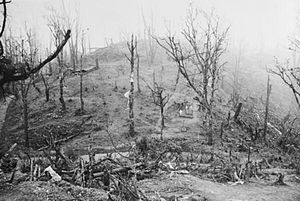
Back معركة كوهيما Arabic ক’হিমাৰ যুদ্ধ Assamese Кохимска битка Bulgarian কোহিমার যুদ্ধ Bengali/Bangla Batalla de Kohima Catalan Schlacht um Kohima German Μάχη της Κοχίμα Greek Batalla de Kohima Spanish نبرد کوهیما Persian Kohiman taistelu Finnish
| Battle of Kohima | |||||||
|---|---|---|---|---|---|---|---|
| Part of Operation U-Go during the Burma Campaign in the South-East Asian theatre of World War II | |||||||
 View of the Garrison Hill battlefield, the key to the British defences at Kohima | |||||||
| |||||||
| Belligerents | |||||||
| Commanders and leaders | |||||||
|
|
| ||||||
| Strength | |||||||
|
Start: 1 infantry brigade (1,500) End: 2 infantry divisions 1 Chindit brigade 1 motor brigade | 1 infantry division (15,000–20,000)[1] | ||||||
| Casualties and losses | |||||||
| 4,064[2] |
5,764–7,000[2] (Combat deaths only, more lost to disease and starvation)[3][4] | ||||||
The Battle of Kohima was the turning point of the Japanese U-Go offensive into India in 1944 during the Second World War. The battle took place in three stages from 4 April to 22 June 1944 around the town of Kohima, now the capital city of Nagaland in Northeast India. From 3 to 16 April, the Japanese attempted to capture Kohima ridge, a feature which dominated the road by which the besieged British and Indian troops of IV Corps at Imphal were supplied. By mid-April, the small British and British Indian force at Kohima was relieved.
From 18 April to 13 May British and British Indian reinforcements counter-attacked to drive the Japanese from the positions they had captured. The Japanese abandoned the ridge at this point but continued to block the Kohima–Imphal road. From 16 May to 22 June the British and British Indian troops pursued the retreating Japanese and reopened the road. The battle ended on 22 June when British and British Indian troops from Kohima and Imphal met at Milestone 109, ending the Siege of Imphal.
In 2013, a poll conducted by the British National Army Museum voted the Battles of Kohima and Imphal as "Britain's Greatest Battle".[5] The Battles of Kohima and Imphal have been referred to by authors such as Martin Dougherty and Jonathan Ritter as the "Stalingrad of the East".[6][7]
- ^ Allen 2000, p. 228.
- ^ a b Allen 2000, p. 643.
- ^ Rooney 1992, pp. 103–104.
- ^ Allen 2000, pp. 313–314.
- ^ "Britain's Greatest Battles". National Army Museum. Archived from the original on 25 December 2013. Retrieved 15 December 2015.
- ^ Dougherty 2008, p. 159.
- ^ Ritter 2017, p. 123.